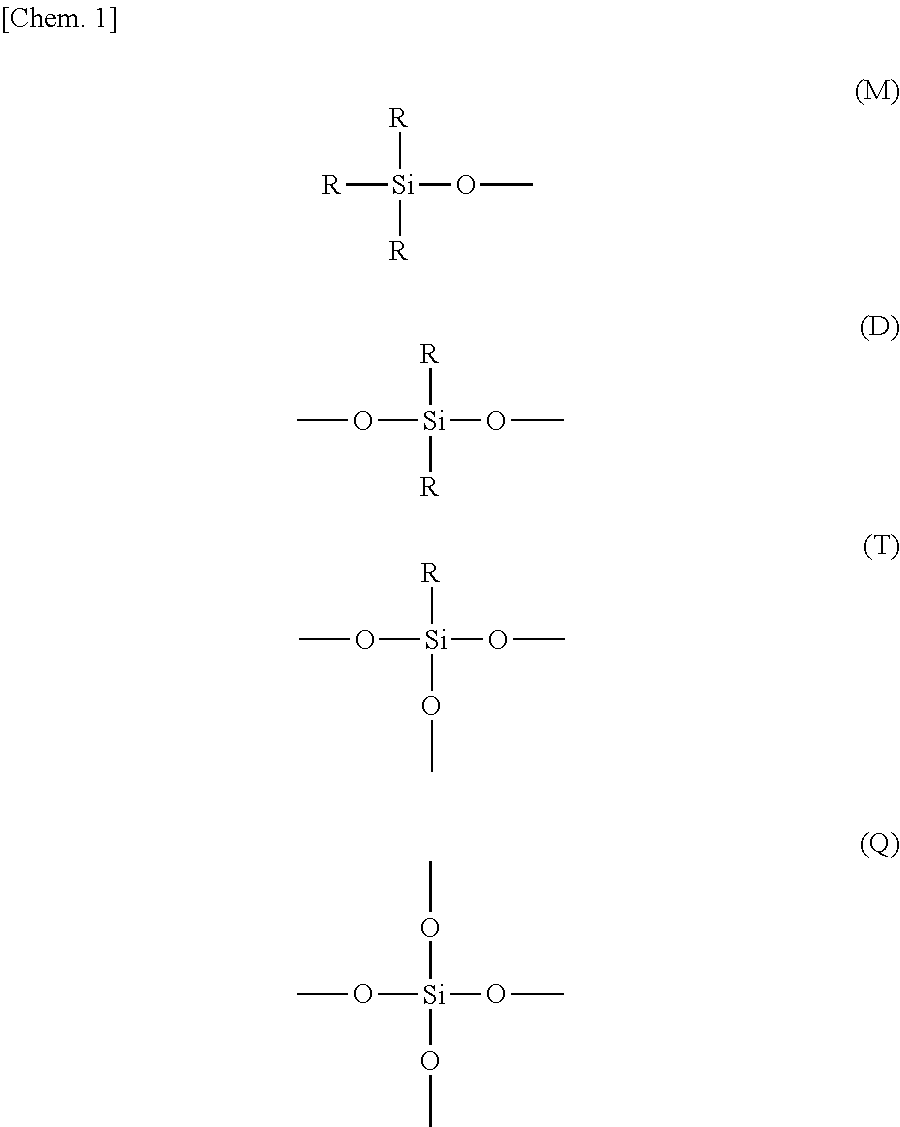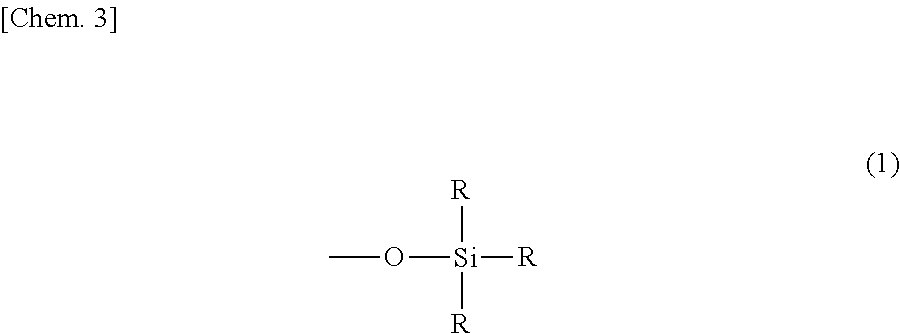Curable resin composition and cured article
a technology of resin composition and cured article, which is applied in the field of cureable resin composition, can solve the problems of poor flexibility, material properties that are not yet satisfactory, and poor and achieves satisfactory flexibility, superior transparency, and excellent resistance to thermal yellowing
- Summary
- Abstract
- Description
- Claims
- Application Information
AI Technical Summary
Benefits of technology
Problems solved by technology
Method used
Image
Examples
synthesis example 1
Synthesis of Ladder-Type Vinylphenylmethylsilsesquioxane
[0105]In a 300-ml four-necked flask were placed 10 g of a ladder-type ethoxy-terminated phenylmethylsilsesquioxane, 3.0 g of a 10 percent by weight tetramethylammonium hydroxide, 200 g of methyl isobutyl ketone, and 5.5 g of dimethylethoxyvinylsilane. The ladder-type ethoxy-terminated phenylmethylsilsesquioxane had a weight-average molecular weight Mw of 2200, an ethoxy group content of 1.5 percent by weight on average per one molecule, and a ratio (molar ratio) of phenyl to methyl of 1:1. The resulting mixture was heated at 45° C. for one hour to complete a reaction. After adding 100 g of ethyl acetate, the reaction mixture was washed with 500 g of water five times. An upper layer after washing was concentrated on an evaporator and evacuated for 30 minutes using a vacuum pump. A liquid ladder-type vinyl-phenylmethylsilsesquioxane [a compound corresponding to the ladder-type silsesquioxane (A) for use in the present invention] ...
synthesis example 2
Synthesis of Ladder-Type H-Phenylmethylsilsesquioxane
[0109]In a 300-ml four-necked flask were placed 10 g of a ladder-type ethoxy-terminated phenylmethylsilsesquioxane, 6.0 g of a 1.3 percent by weight hydrochloric acid, 40 g of toluene, 20 g of isopropyl alcohol, and 10 g of dimethylethoxysilane. The ladder-type ethoxy-terminated phenylmethylsilsesquioxane had a weight-average molecular weight Mw of 2200, an ethoxy group content of 1.5 percent by weight on average per one molecule, and a ratio (molar ratio) of phenyl to methyl of 1:1. The resulting mixture was stirred at room temperature for 3 hours to complete a reaction. A reaction product was concentrated on an evaporator and thereby yielded a solid ladder-type H-phenylmethylsilsesquioxane [a compound corresponding to the ladder-type silsesquioxane (B) for use in the present invention] in an amount of 8.2 g. This compound had a weight-average molecular weight Mw of 2300 and a content of Si—H bonds of 0.16 percent by weight on av...
example 1
[0112]In a 6-mL screw-capped vial were weighed 0.200 g of the ladder-type vinyl-phenylmethylsilsesquioxane obtained in Synthesis Example 1 and 0.124 g of the ladder-type H-phenylmethylsilsesquioxane obtained in Synthesis Example 2, followed by stirring at room temperature for 2 hours to give a homogeneous solution. The resulting solution was combined with 0.4 μL of platinum-vinylmethylsiloxane complex, followed by stirring again. The resulting mixture was applied to a glass plate, heated on a hot plate at 60° C. for 10 minutes, and thereby yielded a colorless, transparent cured article. The cured article was heated in an oven at 180° C. for 168 hours and was found to suffer from no change in color.
PUM
| Property | Measurement | Unit |
|---|---|---|
| temperatures | aaaaa | aaaaa |
| temperature | aaaaa | aaaaa |
| temperature | aaaaa | aaaaa |
Abstract
Description
Claims
Application Information
 Login to View More
Login to View More - R&D
- Intellectual Property
- Life Sciences
- Materials
- Tech Scout
- Unparalleled Data Quality
- Higher Quality Content
- 60% Fewer Hallucinations
Browse by: Latest US Patents, China's latest patents, Technical Efficacy Thesaurus, Application Domain, Technology Topic, Popular Technical Reports.
© 2025 PatSnap. All rights reserved.Legal|Privacy policy|Modern Slavery Act Transparency Statement|Sitemap|About US| Contact US: help@patsnap.com



